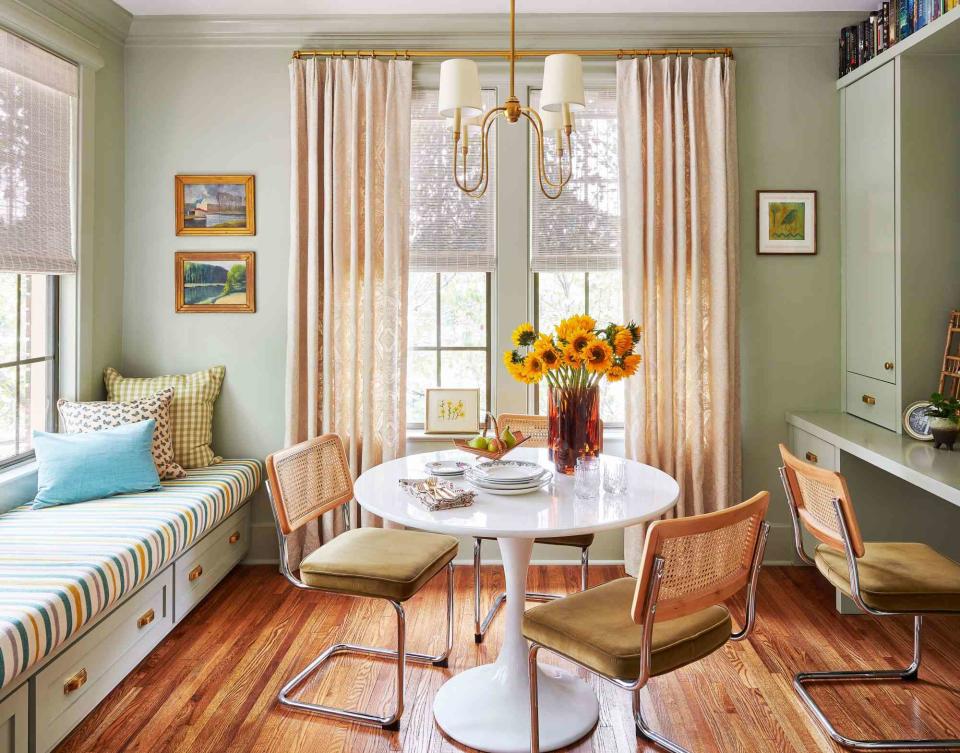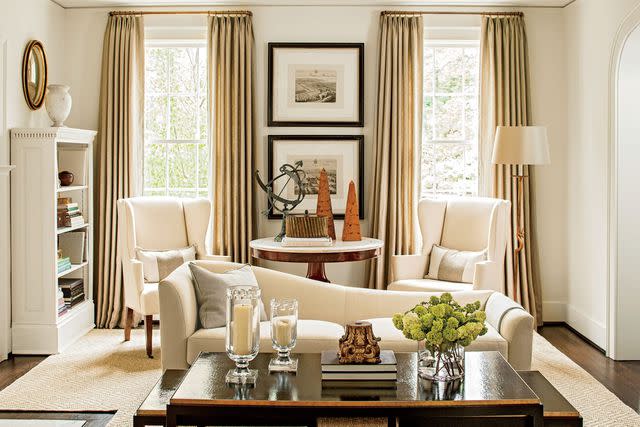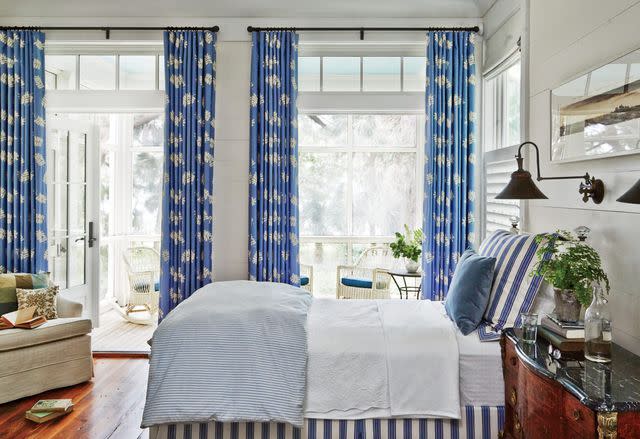21 Types Of Curtains For A Beautiful Window Treatment
A comprehensive guide to curtains.

While they may often be an afterthought, curtains can make or break a room. “Nothing can close off a space or take away from its brilliant design like the incorrect choice of window treatments,” says interior designer Laura Lubin. “They should always be accentuating the space or be intentional with the design.”
To ensure that you’re making the right treatment choice, there’s a few things to consider. Interior designer Sandra Drews Lucas says that when selecting curtains, the first thing to do is determine your window curtain goals. What do you wish for the curtains to accomplish?
Meet The Expert
Laura Lubin is the founder and principal designer of Ellerslie Interiors in Nashville, Tennessee.
Sandra Drews Lucas is an interior designer and a founding partner of Lucas/Eilers Design Associates in Houston, Texas.
Lubin says that her first priority is always considering light requirements. Do you want to let in lots of natural light; Or perhaps you want to block it out? Other elements to think about include how the curtains hang or attach to the wall, their length, and the pleat style.
Our comprehensive curtain guide considers every decision that needs to be made on the path to the perfect window treatment. From there, color and pattern possibilities are just about limitless.

Light
Blackout Curtains
Like their name suggests, blackout curtains completely block out light. Thick and heavy to ensure that no light slips through, blackout curtains are often the drapery of choice for bedrooms, where a blackout can help ensure a better night’s sleep.
Heat Blocking Curtains
No matter where you live in the South, heat blocking curtains can feel heaven-sent. Able to block out the frigid rays of cold winters and the staggering heat of Southern summers, these thermal curtains can help homeowners achieve the ideal home temperature. Plus, they can save you money on your energy bill, since the HVAC won’t have to work so hard.
Sheer Curtains
Rather than stopping light in its tracks, transparent curtains welcome it en masse. This style of drapery softens light and adds effortless style. They’re a favorite of Lubin’s, too.
Light Filtering Curtains
Less translucent than sheers but not as opaque as blackout curtains, light filtering curtains are best for rooms where you want some natural light but would still prefer some privacy. They’re lightweight and allow light to trickle in, but offer a barrier from the outside.

Attachment
Grommet Curtains
Grommet curtains are characterized by open rings at the top, which can easily slide around a curtain rod. They’re a great choice for curtains that will be frequently opened and shut because this attachment style is easy to maneuver and won’t come undone.
Rod Pocket Curtains
Rather than metal rings like grommet curtains, rod pocket curtains have exactly as the name suggests: a pocket for the curtain rod. To secure the drapes, rod pocket curtains are sewn with an opening for the rod to slide through.
This type of curtain attachment is common with blackout curtains because the attachment leaves no room for light to slip in. However, they are not as easy to slide open and shut, so they may be best suited for a window that will have its curtains stay in one position.
Tie-Back Curtains
Curtain tiebacks are a stylish and classy way to hold back curtains and drape them elegantly to the side. Tiebacks can come in the form of loops in the same or a different fabric as the curtains, a rope, a ribbon, or otherwise.
Window Scarf Curtains
A complement to traditionally decorated rooms, window scarf curtains have two curtain panels and additional drapery on top.
Tab Top Curtains
This kind of curtain can be identified by fabric loops sewn in at the top of the drapes. The curtain rod can then be easily slid into these holes to secure the curtains without curtain rings, similarly to rod pocket and grommet curtains.
Double Panel Curtains
This style refers to the instance of having a matching set of drapes that meet in the middle of the window. When drawn, there will then be one panel on each side.
Single Panel Curtains
Rather than having twin curtain panels frame either side of a window, opt for one large panel that can cover the whole thing or be drawn to just one side.

Length
Floor-Length Curtains
“Draperies should always go to the floor, even if the window doesn’t,” advises Lucas. Like the name suggests, these curtains are just the thing to satisfy her expert recommendation.
Puddle-Length Curtains
Longer than floor-length curtains, this kind includes excess fabric that ‘puddles’ on the floor. While they may need to be washed more often, these curtains can satisfy an airy and elegant aesthetic.
Apron-Length Curtains
When curtains fall to just below the window sill, that’s known as apron length. This style is frequently chosen when there is furniture right below the window that longer curtains would interfere with.
Cafe Curtains
Interestingly, cafe curtains only cover the bottom half of a window as opposed to the whole thing. This way, they provide privacy down low, but let light come in unhindered up top into places like the bathroom and kitchen.

Pleats
Flat Top Panel Curtains
Also known as flat pleat curtains and ripple fold curtains, this type of curtain has pleats when its drawn but flattens out completely when the curtains are opened all the way up. They're a go-to curtain choice for Lubin.
“I am a fan of flat top panels for most of the spaces that we design,” she says.
Pinch Pleat Curtains
“I like simple pinch pleat, or flat panel draperies that allow the pattern of the fabric to be the focal point,” says Lucas.
Like flat top panel curtains, pinch pleats are a classic and elegant choice. Pleats are sewn in at the top of the drapes so that they flow down in folds. This type of curtain is highly detailed and often custom.
Pleated Panel Curtains
A more formal style of curtains, pleated panels are often pricey and can be characterized by their symmetrical folds at the top. The pleats are formed by a header tape that pinches when drawn.
Euro Pleat Curtains
Lubin says that one of her favorite curtain styles “would be a euro relaxed pleat for more formal settings like studies and primary bedrooms.” These curtains are pinched at the top but flow gracefully to an open bottom.
Box Pleat Curtains
Unlike the Euro Pleat Curtains which open up, box pleats feature tailored and consistent folds. Deep pleats run the whole length of the drapes.
Inverted Pleat Curtains
For most curtain styles, the pleat is sewn into the front of the panel. However, inverted pleats feature the opposite. Back-sewn pinches are a subtle detail that give drapes a modern and elevated look, but Lubin issues a warning about them.
“An inverted pleat looks beautiful, but requires a very specific type of fabrication in order for the drapery to fall appropriately,” she says. “Done incorrectly they can be very heavy and awkward to use.”
For more Southern Living news, make sure to sign up for our newsletter!
Read the original article on Southern Living.

